Hooray it is time for another brew day! Today we are making a porter to redeem the one we lost last time
due to infection. Since I still have vanilla beans, I decided it was time for a vanilla beer. There are a few things that we have decided to do different today. First we are using less grain, 11.5 lbs, as we have learned the upper limit of our mash tun is around 13 lbs. Second, to achieve better starch conversion and not have a repeat of the
IPA, our mash will last for 90 minutes instead of 60. Finally, we will be reusing some of the Burton ale yeast from the
brown ale we made last time.
Vanilla Porter
9 lbs 2 Row
1 lb Brown Malt
1 lb Biscuit Malt
0.5 lb Chocolate Malt
1 oz Challenger (60 minutes)
WLP023 Burton Ale Yeast
4 oz Maltodextrine
2 Vanilla Beans (secondary)
 |
| Grains |
We started this batch by mashing in the grains at 55
°C. Once they were all incorporated, heating the grain-water mixture had to be very delicate -- I didn't want to kill off the enzymes by overheating it early on.
 |
| Pouring in the grains -- no clumping |
 |
| Swirling the grains in |
One the temperature reached 62°C, I checked to see what the temperature looked like on the bottom of the kettle. That had hit 65°C, so I turned off the burner, covered and let the pot sit for 90 minutes. The downtime was used to finish cleaning and to setup the lauter tun.
 |
| See it now, the cleanest kitchen in this apartment complex |
 |
| Getting the grains to the lauter tun |
Once 90 minutes had passed, I took a little sample of the wort to see how sweet it was. It was indeed sweet, much sweeter than the previous all grain batches had been. The chocolate malt made it taste a lot like coffee. It was now time to transfer the grains over to the lauter tun to remove all the sugar stuck to them.
 |
| Running the sparge arm |
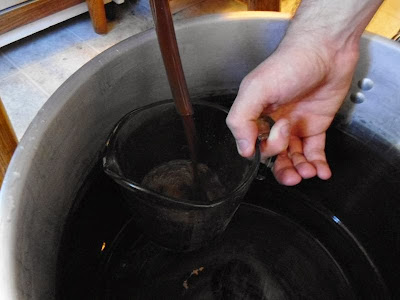 |
| Vorlaufing |
I was a bit concerned during this step because the wort was draining from the lauter tun at turtle speed. I didn't want to disturb the grain bed, so I left it the way it was. Plus no grain bits fell into the kettle at the time so I wasn't too worried. The sparge ended up sticking at the end, so I unstuck it by tipping the lauter tun and pouring more water into it.
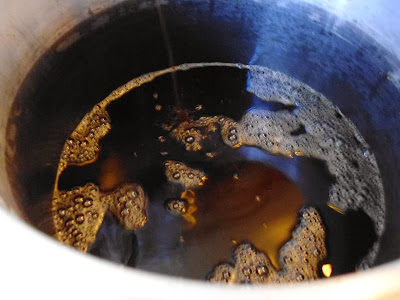 |
| The sweet, black wort |
 |
| Boil time |
I took the original gravity of the wort before starting the boil. With the temperature correction, it was around 1.053, which is much higher than that of the IPA from before. The secret to high conversion has been found: 90 minute mash. Getting this thing to a boil took a while as it had cooled during the stuck sparge.
 |
| Hops and maltodextrin (not cocaine) |
 |
| Honesty, it isn't cocaine |
Once the wort was to a boil, it was time to add the hops and maltodextrin. Usually maltodextrin is sold in 8 oz packages. My homebrew shop ran out of them, but the owner was nice enough to give us some from the 50lb bag they use for their brewery. Maltodextrine has resemblance to a fine, white powdery drug. Jokingly, he wrote "Not Cocaine" on the package, similar to how I write "Not Meth" on all my fermenters.
 |
| Surface is creamy |
 |
| All the foam is gone now |
Boiling and cooling went without any serious issue. I think I found the secret to super quick cooling now; get the sink as full as possible without overfilling it. It took less than 30 minutes to get the wort cool enough to pitching temperature.
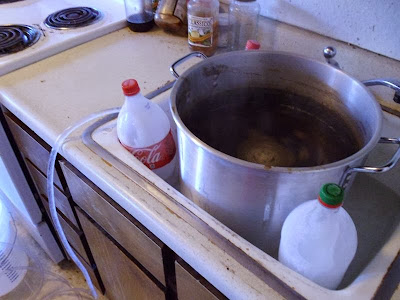 |
| Chillout |
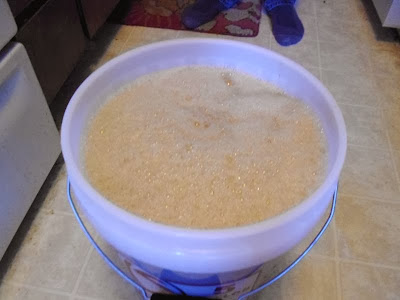 |
| I hope we didn't overfill the fermenter... |
The OG after boiling and adding maltodextrine was
1.070. A new record! I have no idea how low this will ferment, but I'm predicting above
6.5% ABV for this batch. We added in our yeast starter from the yeast we harvested from the
brown ale. Now we wait for the yeast to get started and finish fermenting. If you think I forgot to add the vanilla beans in, I didn't; they will be added into secondary.
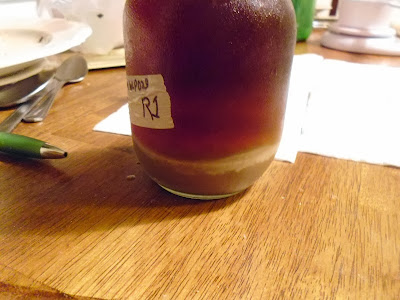 |
| Yeast we harvested from the brown ale. |
 |
| Time for some good beer. |
I will describe the process of adding vanilla beans in when it's time to do so. For now, let's hope that fermentation goes well -- I don't want to deal with an exploding fermenter or another infection....
What is your worst homebrewing accident?
UPDATE: Day 2 of fermentation
What I don't mention in the video is that I had to replace the lid because the other one cracked when I was changing out the tube the first time. I was extremely worried I might have exposed it to bad bacteria, but based on the krausen I saw inside it (GIANT WHITE MOUNTAINS OF FOAM), the yeast should be able to kill anything bad.
Moving to secondary/Adding Vanilla Beans



















No comments:
Post a Comment
Hi folks, please only leave comments relative to the blog post. All spam will be removed and spammers will be blocked.
Note: Only a member of this blog may post a comment.